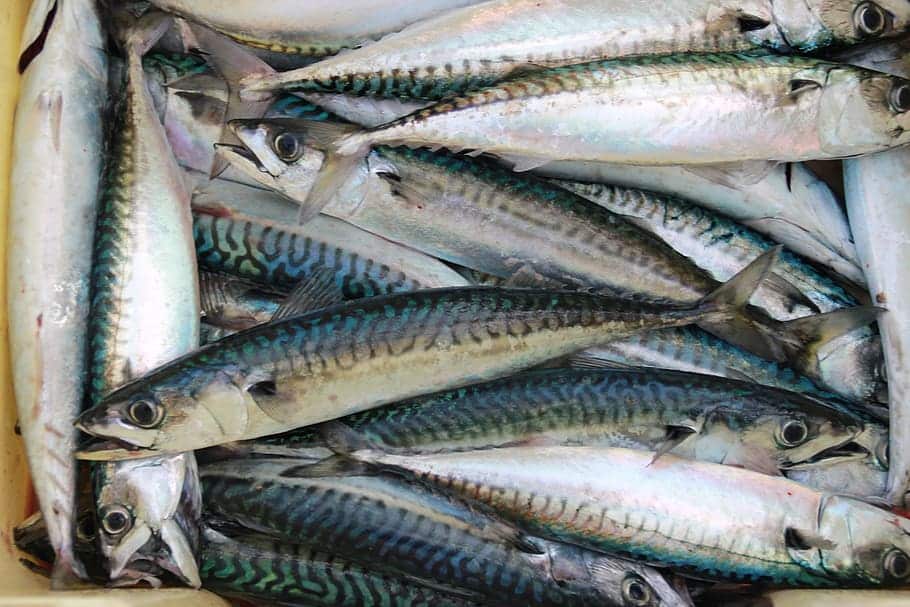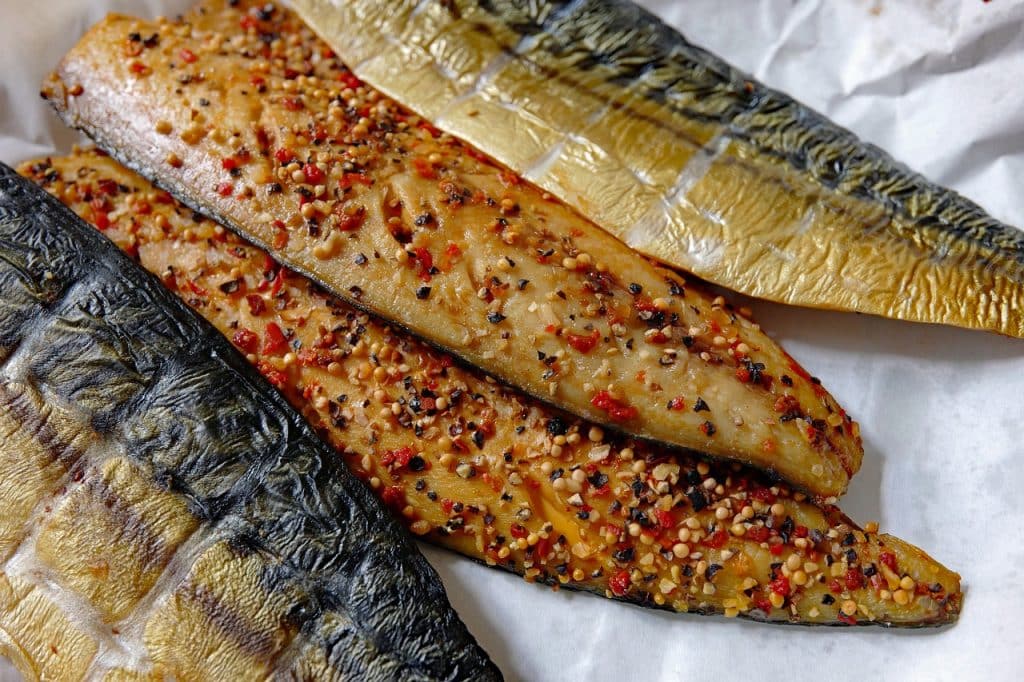People feel excited about adding mackerel to their meals.
Meanwhile, many fish fans may not know important details about canned mackerel.
We’re here to tell you all there is to understand about mackerel in a can, including nutritional facts and its suitability for you.
So, how significant is mackerel in a can for your diet?
Canned mackerel is a tasty seafood dish that’s healthy and full of essential nutrients.
It provides proteins, healthy fats, vitamin D, and minerals (potassium, sodium, and magnesium) that help develop tissues and improve heart health.
However, despite its low mercury levels, caned mackerel can still cause mercury poisoning and should therefore be consumed moderately.
Pregnant and breastfeeding moms should particularly avoid it to prevent the risks of mercury contamination to their babies.
This post will guide you through canned mackerel nutrition, including its benefits and risks of overconsumption.
It will also take you through preparing and consuming this food, and what to watch out for.
Continue reading to learn more.

What to know about mackerel in a can
This seafood provides essential nutrients and is relatively low in mercury.
It’s a healthy food choice, but you should limit its consumption to 2 -3 times a week to enhance your health and safety.
Below is crucial information to know about mackerel in a can:
- Canned mackerel is rich in proteins, healthy fats, and essential nutrients like vitamin D and potassium. It’s a tasty food you can use as a topper on salads or eat singly.
- This fish seafood is processed and preserved in the tin. Before buying, read the label to ensure it’s safe for you; your system should tolerate it and all the preservatives used.
- Canned mackerel is oily, with added sodium and preservatives after processing. It’s relatively high in fats. If you’re on a weight-loss journey, be mindful of how much you eat. The good news is that these fats are beneficial and necessary for human health.
- Although canned mackerel is an excellent source of healthy nutrients and is relatively low in mercury, it’s still a risk for mercury poisoning. Pregnant women and young children are advised to limit their consumption or avoid it.
- Canned mackerel is a versatile dish you can use in various recipes. You can add it to salads, rice, pasta, and cereals. It’s also a good source of protein for vegetarians and vegans.
Is it safe to eat mackerel in a can?
Eating canned mackerel is safe and healthy if you’re not allergic to seafood.
This food forms a significant part of a balanced diet; therefore, you can incorporate it into your main meal.
While in the can, it’s preserved with nutrients kept intact.
However, you should read the label before consuming it.
This will help you understand the ingredients used and the level of processing involved.
Ensure safety by checking the label before buying the canned mackerel.
You can prepare the fish using various recipes, including simmering, frying, and baking.
Canned mackerel will stay good in the can until you open it.
Once opened, transfer the contents into a covered container and store it in the fridge.
Benefits of eating canned mackerel
Canned mackerel is a tasty food that provides several benefits that include:
- Developing tissues – Canned mackerel is an excellent protein source for developing and repairing tissues.
- Improving heart health – This seafood is a good source of omega-3 fatty acids, which are beneficial for heart health. These fats help to lower blood pressure and triglyceride levels, reducing the risks of heart disease. Healthy fats also help to lower cholesterol levels.
- Boosting brain health – Omega-3 fatty acids are beneficial for brain health. They help to improve cognitive function and reduce the risk of dementia.
- Improving joint health – The omega-3 fatty acids in mackerel can also help reduce inflammation and improve joint health.
- Easing depression – Mackerel is a good vitamin B12 source for serotonin production. This vitamin can help ease the symptoms of depression.
- Improving bone health – Canned mackerel is a good source of calcium and vitamin D, which are necessary for bone health.
- Enhancing vision – Omega-3 fatty acids and vitamin A in mackerel support vision.
- Reducing cancer risks – The healthy fats in canned mackerel can help reduce cancer risks.

Possible risks of eating canned mackerel
Canned mackerel is a healthy food, but there are some possible risks associated with eating it.
These risks include:
Mercury poisoning
Although they have little mercury, excess consumption can lead to mercury build-up and poisoning.
Mercury poisoning can cause brain damage, especially in children.
Pregnant women and young children should limit their intake of canned mackerel as they are at higher risk of mercury poisoning.
Allergies
Some people may be allergic to seafood.
The symptoms of a seafood allergy include hives, swelling, difficulty breathing, and anaphylaxis.
If you experience these symptoms after eating canned mackerel, seek medical attention.
Sodium poisoning
Most canned mackerel contain added salt.
This can be a problem for people on a low-sodium diet or with high blood pressure.
It’s essential to check the label and choose a low sodium product.
Gastrointestinal problems
Eating canned mackerel in excess can lead to gastrointestinal problems such as indigestion, diarrhea, and vomiting.
If you experience these symptoms, stop eating the mackerel and see a doctor.
How to prepare and eat canned mackerel
Canned mackerel is a convenient and easy-to-prepare food.
You can eat it straight from the can or cook it in various recipes.
Eating directly from the can
Drain and rinse the fish properly if you’re eating canned mackerel straight from the can.
This will remove any added salt or preservatives.
Cooking canned mackerel by simmering
Simmering is a simple and quick way to cook canned mackerel.
Ingredients:
- 1 can of mackerel
- 1/2 onion, chopped
- 1 carrot, chopped
- 1 celery stalk, chopped
- 1 bay leaf
- Water or broth (enough to cover the vegetables)
Instructions:
- Drain and rinse the mackerel.
- In a pot, simmer the chopped vegetables in water or broth until they are soft.
- Add the mackerel and bay leaf and simmer for 5 minutes.
- Remove from heat and serve.
Cooking canned mackerel by frying
Frying is a more flavorful way to cook canned mackerel.
Ingredients:
- 1 can of mackerel
- 1/4 onion, chopped
- 1 clove of garlic, chopped
- 1 green chili pepper, sliced
- 1 tomato, chopped
- 1 teaspoon of cumin powder
- Salt and pepper
- Frying oil
Instructions:
- Drain and rinse the mackerel.
- In a pan, fry the chopped onion, garlic, and chili pepper in oil until they are soft.
- Add the mackerel, tomato, cumin powder, salt, and pepper – Fry for 5 minutes.
- Remove from heat and serve.
Cooking canned mackerel in tomato sauce
Incorporating tomato sauce is a delicious way to cook canned mackerel.
Ingredients:
- 1 can of mackerel
- 1/2 onion, chopped
- 1 carrot, chopped
- 1 celery stalk, chopped
- 1 bay leaf
- Water or broth (enough to cover the vegetables)
- 1 can of diced tomatoes
- 1 teaspoon of sugar
- Salt and pepper
Instructions:
- Drain and rinse the mackerel.
- In a pot, simmer the chopped vegetables in water or broth until they are soft.
- Add the diced tomatoes, sugar, salt, and pepper. Simmer for 5 minutes.
- Add the mackerel and bay leaf and simmer for 5 minutes.
- Remove from heat and serve.
How to serve canned mackerel
Canned mackerel is a versatile dish that you can consume at various times of the day and for different occasions.
You can eat canned mackerel on its own or serve it with rice, pasta, or potatoes.
It will also go well with other recipes such as fishcakes, curries, and stews.
Use your canned mackerel as a topping for pizza for a wonderful breakfast, or blend it with potatoes or cereal for a great lunch.
You could also make a fish-based pasta sauce by simmering canned mackerel with tomatoes, garlic, and chili peppers.
This will be perfect for dinner when you’re on the road, camping, or brunch with friends.
Frequently asked questions (FAQs)
How can I store canned mackerel?
You can store your canned mackerel in a cool, dry place for up to 2 years before opening.
Once you open the can, you should consume it within 2 days.
After that, store it in the refrigerator for 3 days or freezer for up to 3 months.
Can I eat mackerel bones?
You can eat the bones in canned mackerel, which are soft and edible.
However, you should avoid eating the bones in fresh or cooked mackerel as they may be sharp and dangerous.
Is mackerel better food than tuna?
Mackerel and tuna are both healthy seafood.
They are high in protein and omega-3 fatty acids.
However, canned tuna may contain more mercury than mackerel.
Therefore, it’s essential to eat them in moderation.
How long will mackerel stay after opening the can?
You should consume mackerel within 2 days after opening the can.
After that, you can only store it in the refrigerator for 3 days or freeze it for up to 3 months.
Which canned fish are safe to eat?
Many canned fish options are safe to eat, including salmon, sardines, herring, and mackerel.
However, you should check the label to ensure the fish is wild-caught and canned in water or olive oil.
You should also limit your intake of canned tuna as it may contain more mercury than other fish.
Conclusion
Canned mackerel is nutritious and convenient seafood for different meals.
This fish is rich in protein and omega-3 fatty acids beneficial for health.
It’s safe for fish lovers when taken in moderation, but pregnant women and young children should limit consumption due to the risk of mercury contamination.
Be versatile and creative when preparing this tasty dish and enjoy the benefits that come with it.

Cooking canned mackerel by simmering
Equipment
- 1 Pot
Ingredients
- 1 can mackerel
- 1/2 onion chopped
- 1 carrot chopped
- 1 celery stalk chopped
- 1 bay leaf
- 1 Water enough to cover the vegetables
Instructions
- Drain and rinse the mackerel.
- In a pot, simmer the chopped vegetables in water or broth until they are soft.
- Add the mackerel and bay leaf and simmer for 5 minutes.
- Remove from heat and serve.
Video
Nutrition
- How To Make Passion Fruit Juice - July 1, 2025
- Sara Lee Pound Cake Recipe - July 1, 2025
- Gordon Ramsay Panna Cotta Recipes - July 1, 2025